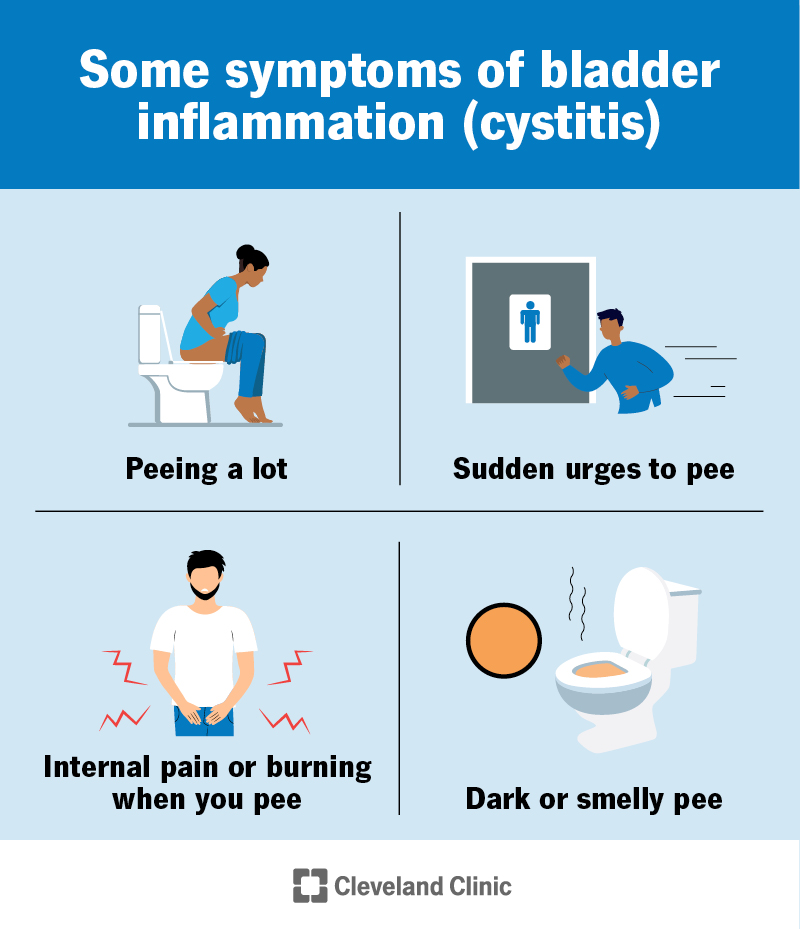Bladder infections can lead to inflammation of your bladder (cystitis). The most common cause of cystitis is an E. coli infection. The most common symptoms include pain or a burning feeling when you pee or peeing more than usual. Treatment includes antibiotics.
Advertisement
Cleveland Clinic is a non-profit academic medical center. Advertising on our site helps support our mission. We do not endorse non-Cleveland Clinic products or services. Policy

Cystitis is inflammation of your urinary bladder, usually because of a bacterial infection. Bacteria from the area between your genitals and rectum (perineum) can get into your urethra and travel up to your bladder. That leads to symptoms that affect how you pee.
Advertisement
Cleveland Clinic is a non-profit academic medical center. Advertising on our site helps support our mission. We do not endorse non-Cleveland Clinic products or services. Policy
Bladder infections are very common, especially in females. About 50% to 60% of females will have cystitis at some point. And these infections may come back (recur) — between 30% and over 40% of females who get a bladder infection will have another one later on.
Males are less likely to get cystitis. That’s because their urethras are longer — about 8 to 9 inches (about 20 centimeters). In females, they’re much shorter — about 1.5 inches (3 to 4 centimeters) long. Because of that, it’s harder for bacteria to reach the bladder in males.
Many people feel shy about bringing up cystitis symptoms. But bladder infections are the most common type of urinary tract infection (UTI). Each year in the U.S., UTIs lead to more than 10 million visits to healthcare providers. You’re not alone. Providers treat them all the time, and you don’t need to feel embarrassed.
There are two main types of cystitis:
Cystitis symptoms commonly include:
Advertisement
If the infection spreads to your kidneys (pyelonephritis), you might also have:
Bacteria cause most bladder infections. The most common one is Escherichia coli (E. coli). It gets into your urethra and multiplies in your bladder.
Other factors that may increase your risk of cystitis include:
You’re also more likely to get cystitis if you’ve had it before.
No, you can’t catch a bladder infection from someone else — even through sexual intercourse. But sex can sometimes let bacteria into your urinary tract and cause an infection.
To help lower your risk after sex, try these tips:
If you don’t treat cystitis, it can spread to your kidneys. This type of infection is an upper urinary tract infection, and it’s harder to treat.
Talk to a healthcare provider if you have symptoms of cystitis. Your provider will usually ask for a pee sample to help diagnose bladder inflammation.
They may run two tests:
Yes, providers often find cystitis with a pee test. But sometimes, your results may look normal, even if you still have symptoms.
If that happens, talk to your provider again. They may do more tests or send you to a urologist for a closer look.
Antibiotics are the fastest way to treat cystitis. Your provider will choose the right one based on the kind of bacteria causing your infection.
You may need antibiotics for three to 14 days, depending on how bad the infection is. Be sure to take all your medicine, even if you start to feel better. If you stop too soon, the infection could come back and be harder to treat.
Some common antibiotics that providers prescribe to treat cystitis include:
You should start feeling better within a few days to a week after you start taking antibiotics.
Call your provider if you have symptoms of cystitis. If you’ve already started treatment but still don’t feel better after a week, contact them again. They may order another test or give you a different antibiotic.
Advertisement
During your appointment, you may wish to ask the following:
With proper diagnosis and treatment, the outlook for cystitis is good. Bladder inflammation often improves by staying hydrated and taking antibiotics. Be sure to finish your entire prescription. Stopping your medication early could lead to the infection coming back.
Antibiotics usually help within a few days to a week. While you heal, avoid foods and drinks that can irritate your bladder, like:
You can help prevent cystitis by adopting the following practices:
Advertisement
Peeing habits might not be something we typically talk about. But a burning feeling when you pee or other changes to your peeing habits mean it’s time to chat with a healthcare provider. You didn’t do anything wrong, and there’s no reason to feel embarrassed or ashamed. They can determine what’s causing your cystitis and prescribe the best treatment.
Advertisement
It can be stressful (and painful) to have bladder disorders, like urinary incontinence or cystitis. But the urology providers at Cleveland Clinic are here for you.

Last reviewed on 05/26/2025.
Learn more about the Health Library and our editorial process.